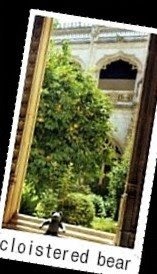Bear Baiting 101
 I know that I've spoken a bit about bull fighting in Spain and how awful it is but I'm mindful that I'm still a bear and bears face some pretty terrible things in this world too. Not to take anything away from the bulls though. So I'm going to put my freelance Good Will Ambassador hat back on and talk about something very close to my heart: bear baiting.
I know that I've spoken a bit about bull fighting in Spain and how awful it is but I'm mindful that I'm still a bear and bears face some pretty terrible things in this world too. Not to take anything away from the bulls though. So I'm going to put my freelance Good Will Ambassador hat back on and talk about something very close to my heart: bear baiting.
Bear baiting? Sounds like something out of medieval Europe doesn't it? Well it was but it's still practised in parts of rural Pakistan.
These unfortunate bears are tethered to a post to await the incessant attacks by several savage pit bull terriers trained to inflict injury. The bears can move but they can't escape and they can't really defend themselves either because their claws, canine teeth & incisors have been plucked - itself a painful procedure. Since molars can't be wrenched out they are usually crushed by a hammer. Poor bears.
Up to 2,000 men will stand around them in a circle and watch and cheer and wager on the outcome. The odds are stacked heavily against the bears. Although illegal (Prevention of Cruelty to Animals Act of 1890, under the Pakistan Wildlife Act, and it's proscribed under Islamic Law too), bear-baiting is a traditional 'sporting' event. This is an afternoon's entertainment. Poor bears. Poor dogs too.
The bears are owned and trained by the Kalanders (a gypsy group) who specialise in training Asiatic black bears. It is believed that there are fewer than 300 Asiatic black bears still in the wild in Pakistan. The adult bears are killed but the cubs are sold to the Kalanders who train them. I don't know how much training is necessary when you're tied to a stake - your only natural weapons of defence having already been removed - and killer dogs lunge for your head.
Bears sustain more injuries than dogs and are permanently scarred with ripped noses and mouths and much worse. Because the bears are so valuable to their owners, they are not put of their suffering but kept alive for future 'fights'. Poor bears. Dogs tend to be far better cared for.
This 'sport' is kept alive by a finely honed network of hunters, wildlife dealers, gypsy bear owners and land owners. But it has to stop now. The World Society for the Protection of Animals (WSPA) has spent a great deal of money on the construction of a sanctuary for rescued bears. The sanctuary is at Kund Park in the northwest of Pakistan. I'd like to visit there to try to cheer those bears up.
Click here to help WSPA in their fight against this barbaric practice. It only takes a minute to send a letter, but think of the difference you can make in a bear's life.
p.s. I was going to feature a photo from a bear-baiting spectacle but I just couldn't. They're too disturbing. Poor bears. Poor dogs.
























